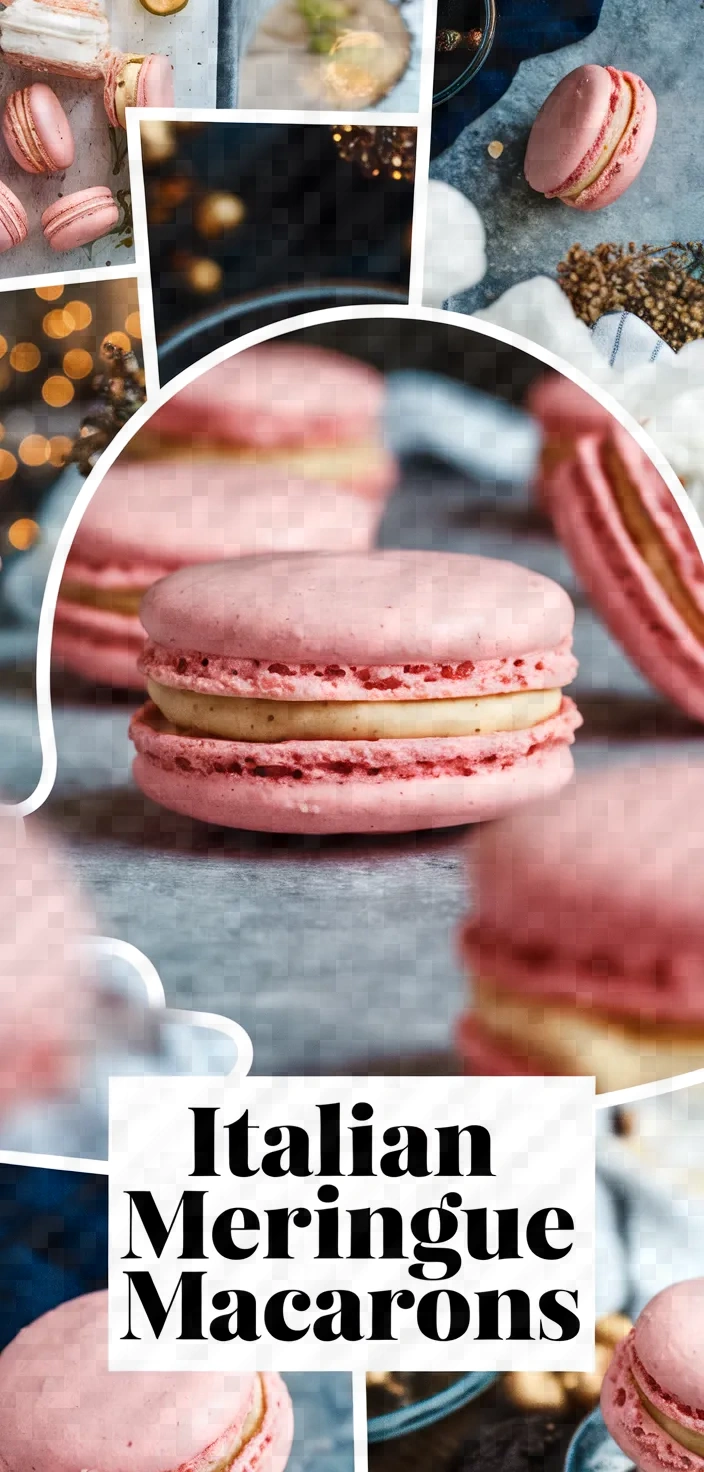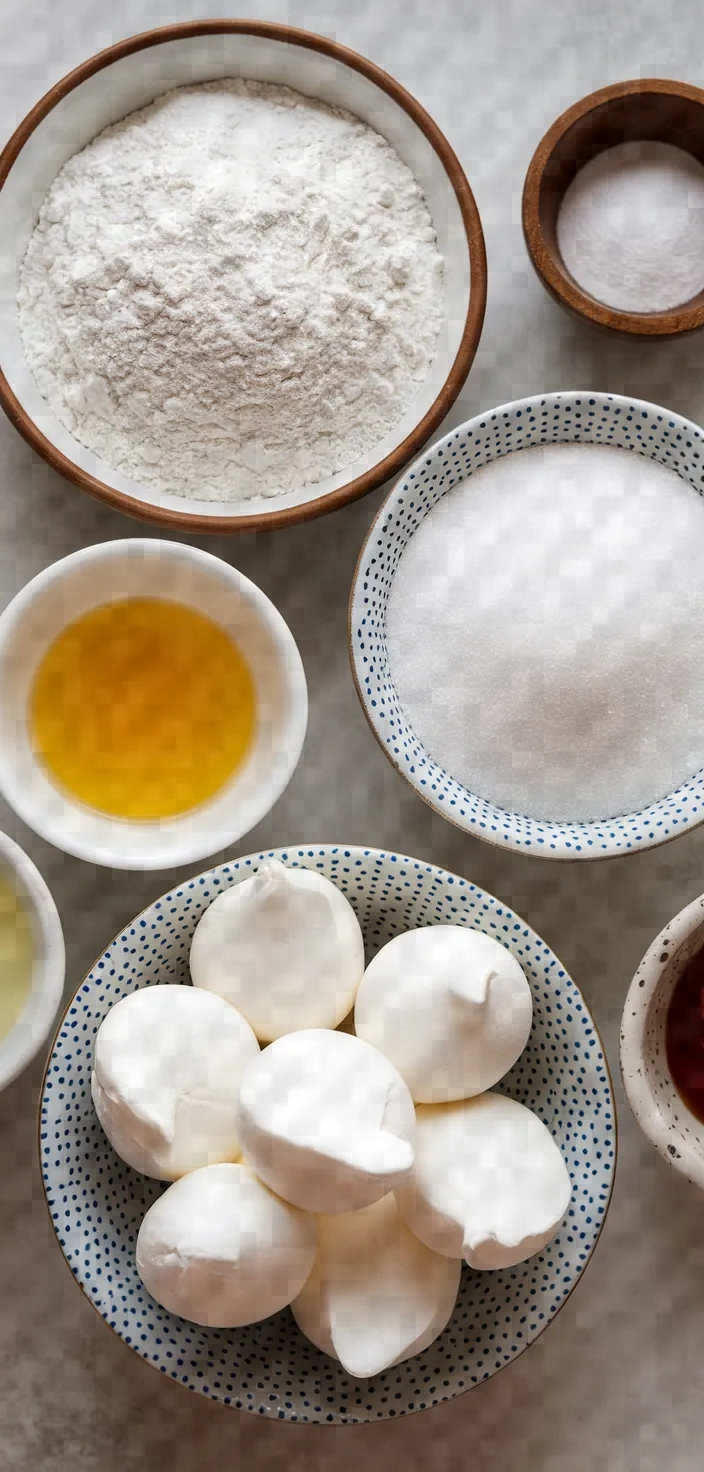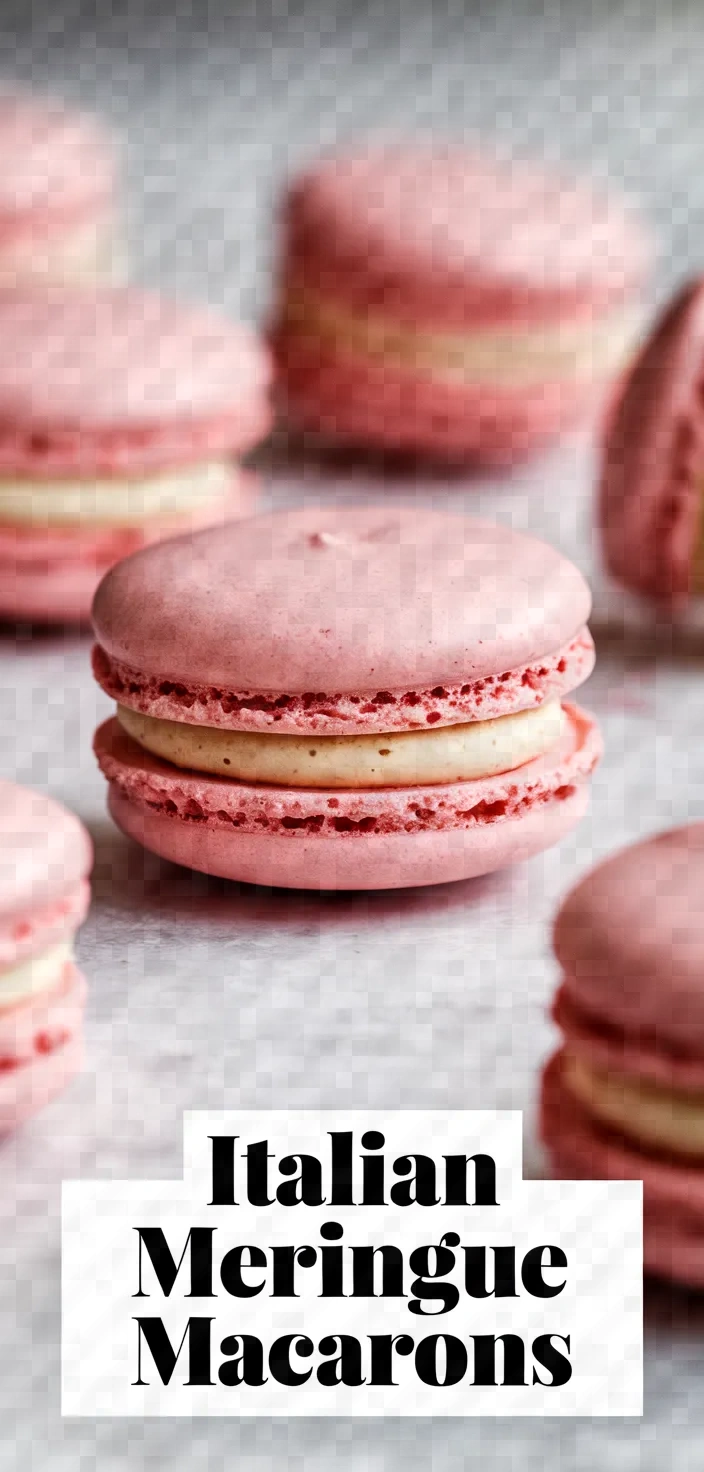Italian Meringue Macarons Recipe
Creating homemade macarons is a delightful journey that challenges my patience and precision, turning simple almond flour, sugar, and aged egg whites into a delicate, colorful treat that feels like a small triumph with every crisp yet chewy bite. Mastering the art of Italian meringue and achieving that perfect macaronage is well worth the effort, as the result is a batch of beautifully filled, flavorful gems that bring pure joy when finally savored after that crucial overnight rest in the fridge.

Making Italian Meringue Macarons is a delightful process that turns regular old ingredients into something magnificent. This classic recipe starts with almond flour and powdered sugar, which whipped up nice and smooth become the crust of the macaron: a rich, smooth, and textured shell.
Then, there is the meringue itself. Those aged egg whites, chopped fine almonds, and powdered sugar not only deliver the right kind of crispness in that first bite but also provide the base for my flavored filling choices.
Pretty much any flavored filling makes a grand complement to the macaron shell. Thus—voila!—the eating
Italian Meringue Macarons Recipe Ingredients

- Almond Flour: Rich in protein, provides nutty flavor and chewy texture.
- Powdered Sugar: Fine texture, adds sweetness and smoothness to macarons.
- Egg Whites: Whipped for volume, structure; protein-based for meringue.
- Granulated Sugar: Creates syrup for Italian meringue; adds stability and sweetness.
- Food Coloring: Optional, adds visual appeal without altering flavor.
Italian Meringue Macarons Recipe Ingredient Quantities
- 150g almond flour
- 150g powdered sugar
- 55g egg whites (aged, for the almond mixture)
- 150g granulated sugar
- 35g water
- 55g egg whites (aged, for the Italian meringue)
- Food coloring (optional)
- Your choice of filling (e.g., buttercream, ganache, jam)
How to Make this Italian Meringue Macarons Recipe
1. Prep the Almond Mixture:
In a large bowl, combine the almond flour and powdered sugar. Discard any large bits that don’t pass through the sifter. Into this mixture, pour in the 55 grams of aged egg whites. Mix until the egg whites, which were not sifted, form a thick paste when combined with the flour and sugar. If you’re using food coloring, add it now and mix to achieve a uniform color throughout.
2. Boil the Sugar Syrup:
In a saucepan, combine 150 g of granulated sugar with 35 g of water. Heat over low to medium heat, stirring until the sugar dissolves. Once dissolved, increase the heat and allow the syrup to come to a boil. Use a candy thermometer and cook until it reaches 118 °C (244 °F).
3. Beat the Meringue:
As the syrup boils, whip 55g of egg whites that have been aged. The egg whites should be in a clean mixing bowl, and you should whip them until they form soft peaks. Meanwhile, ensure that the syrup is boiling away and is, in fact, reaching the temperature you need—112°C to 115°C (234°F to 240°F). When the syrup is ready, pour it slowly into the whipping egg whites while beating them at a high speed. Beat some more until the meringue becomes glossy and forms stiff peaks.
4. Combine the Mixtures:
Folding a third of the meringue into the almond paste loosens the mixture. It is very important to fold carefully; this is a delicate batter that must maintain as much volume as possible. After a third of the meringue has been folded in, the rest can be folded in half at a time, in two more gentle, but firm, folds. When the batter has been combined, it should dribble like thick lava when your spatula is held horizontally over the bowl.
5. Pipe the Macarons:
Place the batter in a piping bag with a plain, round tip. Pipe out even circles in a straight line on the baking tray; then fill in the spaces between the circles to make a full circle. Lightly tap the tray on the counter to settle the piped batter and release any air bubbles trapped inside.
6. Rest the Shells:
Allow the piped macarons to sit at room temperature for 30 to 60 minutes, or until the surface is no longer tacky. At this stage, you can touch the macarons and they will feel somewhat “set,” meaning you can touch them without leaving any noticeable marks.
7. Preheat the Oven
As the shells are at rest, set the oven to a temperature of 150°C (302°F) to preheat.
8. Bake the Macarons:
Cook one baking pan at a time for 14 to 16 minutes. Check for doneness: the tops should be set and not wobbly. Each oven varies, so adjust the time as needed. Cool on the trays for a few minutes; then, when they have firmed up a bit, transfer to wire racks to cool completely.
9. Prepare the Filling:
Select your preferred filling, such as buttercream, ganache, or jam. Make it according to the recipe instructions or your liking.
10. Pair and Fill the Macarons:
Once cooled, pair macarons of equal dimensions.
Pipe or spread your chosen filling onto one of the shells and sandwich it
with its pair. Store the filled macarons in the refrigerator for 24-48
hours before serving for optimal texture. Enjoy!
Italian Meringue Macarons Recipe Equipment Needed
1. Large mixing bowl
2. Sifter
3. Saucepan
4. Candy thermometer
5. Stand mixer or electric hand mixer
6. Mixing bowl
7. Spatula
8. Piping bag with a plain, round tip
9. Baking tray
10. Silicone baking mat or parchment paper
11. Wire racks
12. Oven
13. Kitchen scale
14. Small bowl or container (for aging egg whites)
FAQ
- Q: Can I use almond meal instead of almond flour?A: The smoothest macaron surface is achieved when the flour used is almond flour. Almond meal can be used, but it may contain coarser particles that affect the texture of the macaron. “Flour” here can be taken to mean any kind of ground nut or seed, provided the right size and smoothness are obtained.
- Q: Why do the egg whites need to be aged?To create a stable meringue for macarons, it’s good to use aged egg whites. Aged egg whites have less moisture and are used to solve the standard problem of making meringue. Making meringue is, for the most part, a straightforward endeavor. At its most basic level, it comprises just three ingredients (more on that in a second). Accomplished pastry chefs around the world, however, consider meringue a “problem child” because it is impossibly temperamental, with far too many variables affecting its successful outcome.
- Q: How do I prevent hollow shells in my macarons?A: Make certain not to overmix the batter; verify that your oven temperature is correct; and bake at the right heat and for the right length of time to keep from having hollow shells.
- Q: How can I tell when the sugar syrup is ready for the Italian meringue?The sugar syrup must be at 118°C (244°F) or the soft ball stage when it is added to the egg whites.
- Q: What is the best way to add food coloring?A: Use gel or powdered food coloring instead of liquid. Using a liquid form can change the consistency of your macaron batter.
- Q: Why should macarons be allowed to rest before baking?A: Macarons gain a crucial layer during resting. This layer is key for the characteristic “feet” that the delicate cookies are known to form.
Italian Meringue Macarons Recipe Substitutions and Variations
Almond flour. You can substitute with hazelnut flour or pistachio flour for a different flavor.
Sugar in powder form: Substitute with sugar in powder form, or whir sugar in a blender until it’s fine. Use a sifter to ensure even mixing.
Sugar in granules: For a more delicate syrup, you could use superfine sugar, which has the consistency of powdered sugar, but is not as fluffy. And of course, you could use any kind of sugar in syrup form. Use what you have on hand.
Egg Whites: Fresh egg whites can be replaced with egg white powder mixed with water.
Natural food colorings or powder concentrates from whole foods like beetroot or matcha can be used to tint the colors of the foods.
Pro Tips
1. Use Aged Egg Whites: Aged egg whites are key to a stable meringue, which is crucial for macarons. To age them, separate your egg whites at least 24 hours in advance and store them covered in the refrigerator. Bring them to room temperature before using for better volume.
2. Accurate Temperature Control: Use a candy thermometer to ensure your sugar syrup reaches precisely 118°C (244°F). Undercooked syrup won’t stabilize the meringue, and overcooked syrup will harden too quickly, affecting macaron texture.
3. Correct Folding Technique: When folding the meringue into the almond paste, focus on gentle, deliberate strokes to combine them. Over-mixing can deflate the meringue, while under-mixing can lead to a grainy texture.
4. Consistent Piping: Use a template under your parchment paper to ensure evenly sized macarons. This helps in achieving uniform baking and matching sizes for sandwiches.
5. Resting Period: Don’t skip the resting period before baking. Allowing the piped batter to rest creates a skin, which helps the macarons develop the signature “feet” during baking. The resting time may vary depending on humidity, so check the surface’s dryness before baking.

Italian Meringue Macarons Recipe
My favorite Italian Meringue Macarons Recipe
Equipment Needed:
1. Large mixing bowl
2. Sifter
3. Saucepan
4. Candy thermometer
5. Stand mixer or electric hand mixer
6. Mixing bowl
7. Spatula
8. Piping bag with a plain, round tip
9. Baking tray
10. Silicone baking mat or parchment paper
11. Wire racks
12. Oven
13. Kitchen scale
14. Small bowl or container (for aging egg whites)
Ingredients:
- 150g almond flour
- 150g powdered sugar
- 55g egg whites (aged, for the almond mixture)
- 150g granulated sugar
- 35g water
- 55g egg whites (aged, for the Italian meringue)
- Food coloring (optional)
- Your choice of filling (e.g., buttercream, ganache, jam)
Instructions:
1. Prep the Almond Mixture:
In a large bowl, combine the almond flour and powdered sugar. Discard any large bits that don’t pass through the sifter. Into this mixture, pour in the 55 grams of aged egg whites. Mix until the egg whites, which were not sifted, form a thick paste when combined with the flour and sugar. If you’re using food coloring, add it now and mix to achieve a uniform color throughout.
2. Boil the Sugar Syrup:
In a saucepan, combine 150 g of granulated sugar with 35 g of water. Heat over low to medium heat, stirring until the sugar dissolves. Once dissolved, increase the heat and allow the syrup to come to a boil. Use a candy thermometer and cook until it reaches 118 °C (244 °F).
3. Beat the Meringue:
As the syrup boils, whip 55g of egg whites that have been aged. The egg whites should be in a clean mixing bowl, and you should whip them until they form soft peaks. Meanwhile, ensure that the syrup is boiling away and is, in fact, reaching the temperature you need—112°C to 115°C (234°F to 240°F). When the syrup is ready, pour it slowly into the whipping egg whites while beating them at a high speed. Beat some more until the meringue becomes glossy and forms stiff peaks.
4. Combine the Mixtures:
Folding a third of the meringue into the almond paste loosens the mixture. It is very important to fold carefully; this is a delicate batter that must maintain as much volume as possible. After a third of the meringue has been folded in, the rest can be folded in half at a time, in two more gentle, but firm, folds. When the batter has been combined, it should dribble like thick lava when your spatula is held horizontally over the bowl.
5. Pipe the Macarons:
Place the batter in a piping bag with a plain, round tip. Pipe out even circles in a straight line on the baking tray; then fill in the spaces between the circles to make a full circle. Lightly tap the tray on the counter to settle the piped batter and release any air bubbles trapped inside.
6. Rest the Shells:
Allow the piped macarons to sit at room temperature for 30 to 60 minutes, or until the surface is no longer tacky. At this stage, you can touch the macarons and they will feel somewhat “set,” meaning you can touch them without leaving any noticeable marks.
7. Preheat the Oven
As the shells are at rest, set the oven to a temperature of 150°C (302°F) to preheat.
8. Bake the Macarons:
Cook one baking pan at a time for 14 to 16 minutes. Check for doneness: the tops should be set and not wobbly. Each oven varies, so adjust the time as needed. Cool on the trays for a few minutes; then, when they have firmed up a bit, transfer to wire racks to cool completely.
9. Prepare the Filling:
Select your preferred filling, such as buttercream, ganache, or jam. Make it according to the recipe instructions or your liking.
10. Pair and Fill the Macarons:
Once cooled, pair macarons of equal dimensions.
Pipe or spread your chosen filling onto one of the shells and sandwich it
with its pair. Store the filled macarons in the refrigerator for 24-48
hours before serving for optimal texture. Enjoy!
